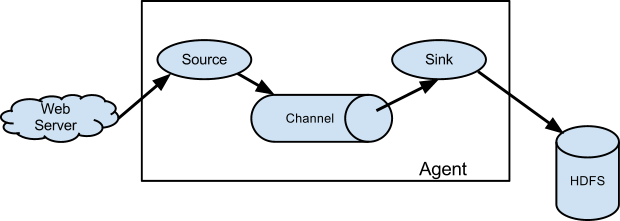Flume 1.4.0 User Guide
来源:互联网 发布:淘宝买家秀排名活动 编辑:程序博客网 时间:2024/06/06 08:45
Apache Flume is a distributed, reliable, and available system for efficiently collecting, aggregating and moving large amounts of log data from many different sources to a centralized data store.
A Flume event is defined as a unit of data flow having a byte payload and an optional set of string attributes. A Flume agent is a (JVM) process that hosts the components through which events flow from an external source to the next destination (hop).

An agent is started using a shell script called flume-ng which is located in the bin directory of the Flume distribution. You need to specify the agent name, the config directory, and the config file on the command line:
$ bin/flume-ng agent -n $agent_name -c conf -f conf/flume-conf.properties.template
Here, we give an example configuration file, describing a single-node Flume deployment. This configuration lets a user generate events and subsequently logs them to the console.
# example.conf: A single-node Flume configuration# Name the components on this agenta1.sources = r1a1.sinks = k1a1.channels = c1# Describe/configure the sourcea1.sources.r1.type = netcata1.sources.r1.bind = localhosta1.sources.r1.port = 44444# Describe the sinka1.sinks.k1.type = logger# Use a channel which buffers events in memorya1.channels.c1.type = memorya1.channels.c1.capacity = 1000a1.channels.c1.transactionCapacity = 100# Bind the source and sink to the channela1.sources.r1.channels = c1a1.sinks.k1.channel = c1
- Flume 1.4.0 User Guide
- flume 1.4.0 user guide
- Flume 1.6.0 User Guide
- Flume 1.6.0 User Guide
- Flume 1.7.0 User Guide
- 《Flume 1.6.0 User Guide》基础入门
- Flume 1.5.0.1 User Guide
- Flume 1.5.2 User Guide
- Flume 学习笔记 一 : Flume User Guide
- 【Hadoop】Flume官方文档翻译——Flume 1.7.0 User Guide (unreleased version)(一)
- 【Hadoop】Flume官方文档翻译——Flume 1.7.0 User Guide (unreleased version)(二)
- 【Hadoop】Flume官方文档翻译——Flume 1.7.0 User Guide (unreleased version)中一些知识点
- flume User Guide翻译-logging raw data / plugin
- user guide
- user guide
- WSO2 Stratos2.0-GUI User Guide
- GCC User Guide
- commons-fileupload user guide
- wpf文件复制显示进度条效果(双线程)
- curl http上传文件
- 在activity中屏蔽home键的方法
- win7系统下java、tomcat的环境变量配置
- oracle中distinct和group by的区别
- Flume 1.4.0 User Guide
- 面试题--对象序列持久化
- 安装SVN及实现nginx web同步更新需要在WDCP一键安装包的基础上
- JavaScript知识点之:switch比较
- 2013-08-02(周五)
- Luene高亮器
- 表单提交校验问题
- 常见异常
- 【程代展】读书、科研与人生道路


